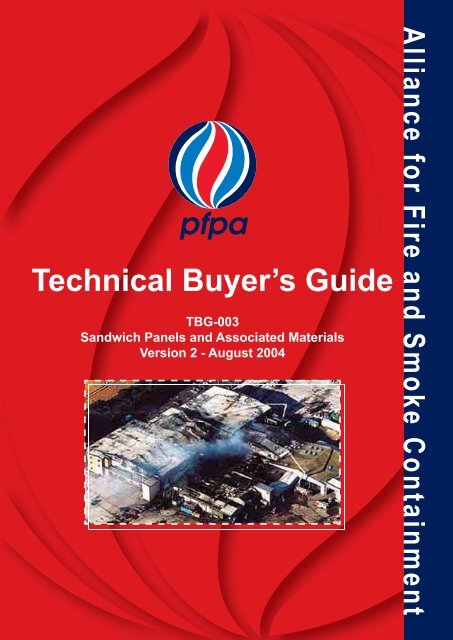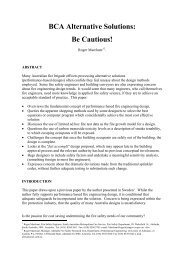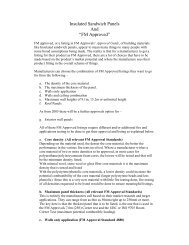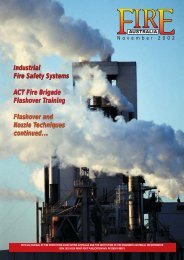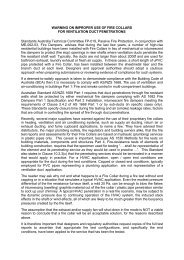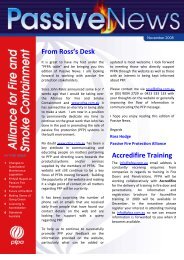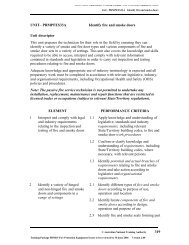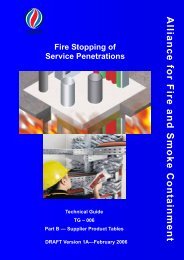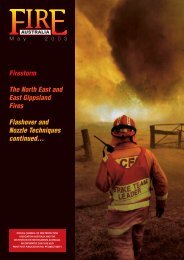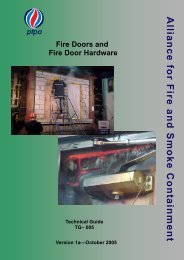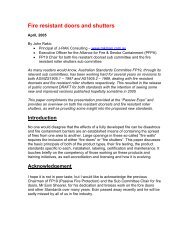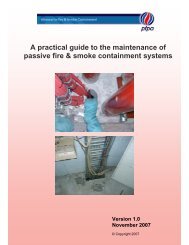Containment
Technical Buyer's Guide - PFPA
Technical Buyer's Guide - PFPA
- No tags were found...
Create successful ePaper yourself
Turn your PDF publications into a flip-book with our unique Google optimized e-Paper software.
Technical Buyer’s Guide<br />
TBG-003<br />
Sandwich Panels and Associated Materials<br />
Version 2 - August 2004<br />
Alliance for Fire and Smoke <strong>Containment</strong>
The Alliance for Fire and Smoke <strong>Containment</strong> (The Alliance) is a group formed<br />
to increase the profi le of passive fi re and smoke containment systems and<br />
their benefi ts to the Building and Construction Industry and the Community as<br />
a whole.<br />
The complex nature of Australia and New Zealand Standards, Fire Safety Engineering<br />
methodologies, building control regulations and legislation means that The Alliance for Fire<br />
and Smoke <strong>Containment</strong> can assist its members in understanding the requirements, by<br />
providing a unifi ed voice to integrate into relevant reform initiatives.<br />
At the same time, where regulations and legislation is lacking or confl icting, The Alliance can<br />
draw on the resources of its members to develop Technical Guidance Notes (TGN’s) and<br />
Industry Best Practice Guides (IBPG’s). These are developed with other relevant industry<br />
groups (Insurance Companies, Testing Laboratories, Manufacturers and Consumers)<br />
and government organisations (Fire Brigades and Local Councils) to ensure they are<br />
representative of all relevant party interests.<br />
The Alliance for Fire and Smoke <strong>Containment</strong> provide a number of ancillary services,<br />
including:<br />
• A comprehensive and user friendly web site for:<br />
° Find-a-product<br />
° Find-an-installer<br />
° Find-a-consultant<br />
° Technical Papers<br />
• Technical and Legislative Overviews<br />
• Technical Buyer’s Guides<br />
• Industry Best Practice Guides<br />
• Passive News: Quarterly Industry Newsletter<br />
• E-News Update: Industry Updates as they occur<br />
• Industry Forum: Quarterly Members Meeting<br />
• Trade Exhibition Representation<br />
Although care has been taken to ensure, to the best of our knowledge, that all data and information contained in this publication is<br />
accurate to the extent that it relates to either matters of fact or accepted practice or matters of opinion at the time of publication, The<br />
Alliance for Fire and Smoke <strong>Containment</strong> assumes no responsibility for any errors in or misinterpretations of such data and/or information<br />
or any loss or damage arising from or related to its use.<br />
1.
Preface<br />
This publication has been published by The Alliance for Fire and Smoke <strong>Containment</strong> with<br />
the kind support of sponsoring companies who are all actively involved in the Sandwich<br />
Panel Industry.<br />
It presents a list of commercially available Sandwich Panel Systems and associated<br />
components along with a summary of the respective company’s available fi re test data as<br />
supplied at the time of compilation.<br />
Part 1 provides general information on sandwich panels, various core materials, fi re testing<br />
and fi re test data, Australian and New Zealand National Regulatory (Building Control)<br />
requirements and the evolving Insurance Industries own requirements.<br />
Part 2 is a guide to using the Technical Buyer’s Guides Tables and provides an overview of<br />
the relevant international and local test standards.<br />
Part 3 contains the Technical Buyer’s Guide which include listings of the Sandwich Panel<br />
System or associated component supplier, the nominated product category and a summary<br />
of available fi re test data.<br />
This publication will provide a useful reference document to architects, designers,<br />
manufacturers, suppliers, installers, building approval offi cers, insurance underwriters or<br />
surveyors, risk management consultants, or building owners and operators.<br />
This is the fi rst Alliance Technical Buyer’s Guide and work has commenced on other similar<br />
guides for construction products in bushfi re prone areas, fi reproofi ng of structural steel and<br />
others.<br />
Acknowledgements<br />
We would like to thank the Sandwich Panel members of The Alliance for completing the<br />
relevant surveys and providing detailed information on their materials and systems without<br />
which this publication could not have been prepared.<br />
John Rakic<br />
Executive Offi cer<br />
The Alliance for Fire and Smoke <strong>Containment</strong><br />
© 2004 The Alliance for Fire and Smoke <strong>Containment</strong><br />
Disclaimer<br />
This publication was prepared by J-RAK Consulting for The Alliance for Fire and Smoke <strong>Containment</strong> (The Alliance).<br />
Information provided within is based on data provided by the respective suppliers. Product listings do not signify that the<br />
products listed are endorsed in anyway by The Alliance. The user is urged to contact the supplier and request data sheets<br />
and technical assistance for the application at hand.<br />
www.pfpa.com.au<br />
2.<br />
TBG-03.2
Contents<br />
The Alliance for Fire and Smoke <strong>Containment</strong><br />
About The Alliance Overview 4<br />
Part 1<br />
Sandwich Panels and Fire Testing<br />
Introduction 7<br />
What is a sandwich panel? 7<br />
Core materials 8<br />
Fire testing and fi re test data—an explanation 10<br />
Australasian Regulatory Requirements 12<br />
Insurance Industry Requirements 15<br />
Part 2 How to use this guide 18<br />
Part 3<br />
Technical Buyer’s Guide Tables<br />
Table 1 Finished Sandwich Panel Products 27<br />
(Australia)<br />
Table 2 Sandwich Panel Core Materials 28<br />
(Australia)<br />
Table 3 Finished Sandwich Panel Products 30<br />
(New Zealand)<br />
Table 4 Sandwich Panel Core Materials 31<br />
(New Zealand)<br />
Notes 32<br />
Sponsors 33<br />
TBG-03.2<br />
3. www.pfpa.com.au
About the Alliance<br />
The Alliance for Fire and Smoke <strong>Containment</strong><br />
(The Alliance) was formed in early 2002 with the<br />
support of founding members to provide a uniform<br />
and coordinated approach for the passive fire<br />
protection industry sub-sector.<br />
The Alliance allows members to deliver relevant<br />
information to all building professionals via a web<br />
site, writing and disseminating technical papers,<br />
seminar presentations, quarterly newsletter and<br />
relevant electronic email updates.<br />
The Alliance also provides a forum for memebers to<br />
participate in legislative, regulatory and Australian<br />
Standards Reform Initiatives.<br />
Consultants, designers, installers, manufacturers,<br />
suppliers and maintenance providers are all<br />
encouraged to support and actively participate to<br />
improve best practice in the passive fire protection<br />
industry by becoming financial Alliance members.<br />
Initiatives<br />
Code of practice for property protection and<br />
protection against business interruption<br />
A major project being chaired by the Executive Officer<br />
of the Alliance working closely with the insurance<br />
industry and other key stakeholders.<br />
Accreditation, licensing and training of installers and<br />
maintenance providers<br />
Seen as the key to improving the professionalism of<br />
our industry sector. The Alliance is working closely<br />
with other peak bodies on this initiative.<br />
Corresponding member on the ABCB Industry<br />
Liaison Committee<br />
Allows input into Building Code of Australia<br />
changes.<br />
Local and International Standards representation<br />
Encompassing both ISO and AS/NZS standards for<br />
fire and smoke containment<br />
www.pfpa.com.au<br />
A web site allowing exposure for members and<br />
a cost effective means of communication to all<br />
industry professionals<br />
NEW LUXALON ® SANDWICH WALL<br />
PANEL IS SMOOTH OPERATOR<br />
The new LUXALON ® HP+ Sandwich Wall System<br />
from Hunter Douglas Limited offers design flexibility<br />
with unparalleled thermal and fire performance.<br />
Applied as a flat, curved or cranked façade, LUXALON<br />
HP+ Sandwich Wall enables a completely concealed<br />
fixing method and creates a virtually airtight, thermally<br />
broken system.<br />
Panels are custom manufactured using metals,<br />
including aluminium.The system integrates with<br />
windows, doors and louvres. A wide range of colours<br />
and surface finishes are available.<br />
LUXALON HP+ Sandwich Wall’s fire performance<br />
was recently FM tested in the United Kingdom, where<br />
it met the standards required for building insurance<br />
purposes.<br />
1300 651 968<br />
Contact us for more information<br />
and product samples or visit our website<br />
www.luxalon.com.au<br />
ARCHITECTURAL PRODUCTS
PART 1<br />
Introduction<br />
Sandwich Panels and Fire Testing<br />
What is a sandwich panel ?<br />
By far one of the most topical issues in recent<br />
times relating to the fi eld of Passive Fire & Smoke<br />
<strong>Containment</strong> is that of fi re resistance properties<br />
and/or the reaction to fi re properties of buildings<br />
constructed from or incorporating signifi cant<br />
quantities of modular and insulating (sandwich)<br />
panels.<br />
In recent times, here in Australia and New Zealand,<br />
we have seen some changes in the use of sandwich<br />
panels by both the insurance companies and also<br />
by our Regulators through changing requirements<br />
in the Building Codes of both countries, particularly<br />
relating to the reaction to fi re requirements for wall<br />
and ceiling lining materials.<br />
Sandwich panels are typically single piece, modular<br />
factory engineered units comprising two metal faces<br />
and a fully insulating core.<br />
The facings are fully bonded to the core so that the<br />
panel acts compositely when under load, in most<br />
cases, providing free standing panels. Facings used<br />
for insulated panels are predominantly of steel.<br />
The core material is usually a material that provides<br />
good thermal insulation properties. The insulating<br />
core is typically bonded to the facings using a<br />
conventional adhesive bond.<br />
It would be fair to say that there is a great deal<br />
of confusion and miscommunication in the<br />
wider industry, as those of us involved in the<br />
building industry, be it as architects, designers,<br />
manufacturers, suppliers, installers, building<br />
approval offi cers, insurance underwriters or<br />
surveyors, risk management consultants, or<br />
building owners and operators for that matter, would<br />
have observed.<br />
This Technical Buyer’s Guide (August 2004 Edition)<br />
has been prepared by the Alliance for Fire &<br />
Smoke <strong>Containment</strong> to try and provide both a basic<br />
overview on some of the relevant terminology and<br />
issues and most importantly a starting point for<br />
those of you who are trying to fi nd manufacturers<br />
and suppliers of sandwich panels and associated<br />
products. This Guide will allow you to visit the<br />
relevant manufacturer and supplier web sites and<br />
to contact them to receive more information and<br />
discuss your own exacting requirements.<br />
Figure 1: Section through a typical sandwich panel.<br />
(Photo: Courtesy of Bondor).<br />
The panels are typically manufactured on a<br />
continuous production line, as shown below.<br />
We would like to stress, that we have prepared this<br />
document in good faith to try and provide a central<br />
starting point for end users, and the Technical<br />
Buyer’s Guide Tables have been compiled from<br />
information provided by the manufacturers and<br />
suppliers themselves. The readers are urged to<br />
contact the relevant manufacturers and suppliers<br />
and to do their own due diligence in relation to the<br />
products listed. We take no responsibility for any<br />
errors or omissions and we reserve the right to<br />
change this document without any notice.<br />
Like any other publication produced by The Alliance<br />
for Fire & Smoke <strong>Containment</strong>, we would be happy<br />
to receive constructive criticism and feedback from<br />
readers so we can improve future versions.<br />
Figure 2: A continuous production line.<br />
(photo: Courtesy of Bondor).<br />
TBG-03.2<br />
7. www.pfpa.com.au
Core Materials<br />
For the purposes of this Guide, the following<br />
generic core material types have been used:<br />
PUR<br />
PIR<br />
Mineral Wool / Stone Wool<br />
Phenolic foams<br />
EPS (Expanded polystyrene)<br />
Phenolic/EPS Composites<br />
Proprietary<br />
The following sub sections provide a very basic<br />
overview on each generic core material type and<br />
some basic fire performance attributes for the generic<br />
core material type when considered in isolation, (not<br />
when incorporated within a sandwich panel).<br />
Figure3: Sandwich panels ready for shipping incorporating<br />
mineral fi bre/stone wool core material.<br />
Photo: Courtesy of CSR Panel Systems.<br />
Whilst this information is interesting and has been<br />
provided because questions like this are continually<br />
being asked of us at The Alliance for Fire & Smoke<br />
<strong>Containment</strong>, it should be stressed, that when<br />
the core material is incorporated into a steel<br />
faced insulated (sandwich) panel system, the<br />
protection provided by the metal facings, joints,<br />
fixings and the support system may greatly<br />
modify the fire performance indicated for the<br />
core insulation materials in isolation.<br />
The practical performance of the complete and<br />
proprietary insulated panel system can only be<br />
evaluated by the use of full-scale fire tests.<br />
The fire properties of core materials can vary<br />
significantly according to the generic type of<br />
insulating core and the specific proprietary<br />
formulation.<br />
Polyurethane (PUR)<br />
Rigid polyurethane (PUR) materials are cellular<br />
thermosetting insulation materials that typically form<br />
a char when subject to heat and flame impingement.<br />
The char acts as an insulator that affords some<br />
protection to the underlying product. However,<br />
PUR will burn by charring and pyrolising producing<br />
significant quantities of smoke in the process.<br />
Polyisocyanurate (PIR)<br />
Rigid polyisocyanurate (PIR) insulation materials are<br />
created by the trimerisation of three molecules of the<br />
polymeric isocyanate used in their formulation. As a<br />
result, when tested in isolation, the rate of pyrolysis<br />
is reduced compared to PUR materials, the strength<br />
of the char is increased, and the protection to the<br />
underlying insulation is enhanced.<br />
This results in the reduction of the amount of damage<br />
created by the incident of fire with a consequent<br />
reduction of smoke production.<br />
Figures 4 and 5: Typical as built facilities incorporating<br />
sandwich panels.<br />
Photos: Courtesy of CSR Panel Systems.<br />
www.pfpa.com.au<br />
8.<br />
TBG-03.2
Mineral fibre / Stone wool (MF/SW)<br />
Mineral fibre/stone wool insulating core materials<br />
are created from molten glass, stone or slag that is<br />
spun into a fibre like structure and bonded together<br />
using organic binders. When tested in isolation (to<br />
relevant standards such as AS1530 part 1) the fibre<br />
performance is classified as non-combustible or at<br />
worst, of limited combustibility.<br />
In terms of fire alone, mineral fibre/stone wool is a<br />
reliable fire protection material, since it is both noncombustible<br />
and does not conduct heat. This means<br />
that it will not propagate fire and can withstand<br />
temperatures above 1000°C.<br />
When incorporated within a sandwich panel structure<br />
mineral fibre/stone wool insulating core materials<br />
are suitable for a range of applications where fire<br />
retardant properties are essential, for example<br />
internal and external walls, ceilings and partitions.<br />
Phenolic foams<br />
Phenolic foams contain a polymeric structure that<br />
offers a considerable resistance to degradation<br />
by heat. Accordingly, like PIR products they are<br />
thermosetting, forming a char in isolation which<br />
adds a high degree of protection to the underlying<br />
insulation.<br />
Proprietary<br />
Proprietary core materials are those which do not<br />
fall within the generic core material categories listed<br />
above.<br />
Core Identification Guide<br />
These generic core materials typically have the<br />
following appearance:<br />
EPS<br />
The characteristics are maintained when the<br />
product is incorporated into insulated panels. Smoke<br />
production is also low by comparison with most other<br />
polymeric materials.<br />
Expanded polystyrene (EPS)<br />
Polystyrene is a thermoplastic that melts when<br />
subjected to excessive heat. Chemical flameretardants<br />
are typically added which do improve the<br />
fire performance, but when exposed to sustained<br />
flame impingement even these flame retardant<br />
polystyrene materials will burn and they typically<br />
produce large quantities of smoke.<br />
The softening temperature is approximately 100°C<br />
and melting temperature 180°C. As the temperature<br />
increases the polystyrene melts and recedes from<br />
the heated surface creating a void.<br />
Phenolic /EPS Composites<br />
A relatively new development is the Phenolic -<br />
Expanded Polystyrene (EPS) hybrid core material.<br />
These composite materials, consisting of EPS beads<br />
encapsulated in a Phenolic matrix, they combine<br />
the fire performance and some relatively low smoke<br />
production properties of Phenolic core materials, as<br />
well as the thermal insulation properties of EPS core<br />
materials.<br />
PUR<br />
MF/SW<br />
PIR<br />
Phenolic Foam<br />
The introduction of the Phenolic matrix results<br />
in a core material of limited comustibility which<br />
experiences similar char caracteristics to other<br />
thermosetting type plastic materials.<br />
Phenolic/EPS Composites<br />
Note: These colours are representative only and are given as a<br />
very basic guide.<br />
TBG-03.2<br />
9. www.pfpa.com.au
Fire testing and fire test data—<br />
an explanation<br />
What is the difference between “reaction to fire”<br />
and “fire resistance” testing?<br />
National Regulations typically have specifi c<br />
requirements relating to wall and ceiling linings<br />
and/or sandwich panels, for both “reaction to fi re”<br />
properties and “fi re resistance” properties. For<br />
both properties, fi re-testing standards are typically<br />
referenced from which ratings of products can be<br />
determined which can be used to show compliance<br />
against nationally accepted thresholds.<br />
Complying materials according to National<br />
Regulations are required to undergo a fi re resistance<br />
test, and achieve fi re resistance grading periods,<br />
usually in hours or minutes for criteria including<br />
structural adequacy (load bearing capabilities<br />
under fi re), integrity (ability to retard the passage<br />
of hot fl ames and gases), and insulation (ability to<br />
limit the temperature rise from the exposed face /<br />
fi re side, to the non-exposed face / non-fi re side).<br />
Note: In Australia this rating is known as the FRL (Fire<br />
Resistance Level), whilst in New Zealand it is known as<br />
the FRR (Fire Resistance Rating).<br />
The following sub sections should help explain<br />
what the subtle but important difference between<br />
“reaction to fi re” and “fi re resistance” properties.<br />
Reaction to fire properties and contribution to<br />
“fire load”<br />
Wall and ceiling (roof) lining materials, such as<br />
sandwich panels, of course depending on the core<br />
materials and/or installation characteristics, can<br />
add signifi cantly to the so called “fi re load” within<br />
the enclosure they are bounding.<br />
An increase in “fi re load” means that the products<br />
themselves will assist in propagating the spread of<br />
fi re and smoke in many fi re scenarios. This fact is<br />
recognised in most National Building Regulations,<br />
where there is some attempt to control the types<br />
and quantities of materials used and to limit the<br />
impact on fl ame and smoke spread in the advent<br />
of a fi re.<br />
Complying materials, according to National<br />
Regulations have typically been required to undergo<br />
a small-scale reaction to fi re test, and to achieve<br />
ratings under predetermined thresholds for fi re and/<br />
or smoke spread, according to the circumstances<br />
of their use.<br />
Real fi res and reputable international research has<br />
questioned the validity of using small-scale reaction<br />
to fi re tests to accurately determine the suitability of<br />
a product for use as a wall and ceiling lining. The<br />
international trend, in many ways fast tracked by<br />
the insurance industry’s own initiatives, is to move<br />
towards more expensive, but more defi nitive, fullscale<br />
reaction to fi re tests.<br />
Fire resistance properties and “fire walls”<br />
Sandwich panel systems, may be used as fi re<br />
resistant barriers (sometimes referred to as<br />
“fi re walls”) as required under National Building<br />
Regulations. In this specifi c scenario, in addition to<br />
the reaction to fi re property requirements, the wall or<br />
roof / fl oor / ceiling system must in fact be capable<br />
of being an effective barrier against the spread of<br />
a fi re between respective fi re compartments or fi re<br />
cells.<br />
Figure 6: A specimen undergoing a cone calorimeter reaction to<br />
fi re test.<br />
Photo: Courtesy of BRANZ<br />
Figure 7: A specimen undergoing a full scale fi re resistance test.<br />
Photo: Courtesy of J-RAK Consulting<br />
www.pfpa.com.au<br />
10.<br />
TBG-03.2
Australasian Regulatory Requirements<br />
Australia<br />
The technical provision relating to Building Control<br />
have been consolidated Nationally in Australia<br />
under the Building Code of Australia (BCA), which<br />
has been in all States & Territories through their<br />
respective Building Control related legislation. The<br />
Australian Building Codes Board, ABCB, currently<br />
maintains the BCA.<br />
New Zealand<br />
The introduction of the Building Act in New Zealand<br />
in 1991 consolidated a wide range of previous<br />
building-related legislation and also established the<br />
Building Industry Authority (BIA), who administers<br />
the New Zealand Building Code (NZBC). The<br />
various clauses of the performance-based NZBC<br />
can be met by satisfying the requirements of the<br />
prespective BIA Acceptable Solution, or by a<br />
performance-based Alternative Solution.<br />
Australian Reaction to fire requirements<br />
The reaction to fire requirements for wall and ceiling<br />
lining materials contained within the BCA have<br />
recently been reviewed and a new Specification<br />
C1.10a has been introduced to run in parallel for a<br />
grace period of 2 years (expiring July 1 st 2005) with<br />
existing Specification C1.10<br />
The previous requirements, contained within BCA<br />
Specification C1.10, utilize the Spread-of-Flame,<br />
Smoke Developed and Flammability Indices of<br />
a material determined by testing the material in<br />
accordance with the small-scale reaction to fire<br />
test, Australian Standard AS1530.3 - “Simultaneous<br />
determination of ignitability, flame propagation,<br />
heat release and smoke release”. This small-scale<br />
reaction to fire test standard sets out a test method<br />
for the assessment of materials and components<br />
according to their tendency to ignite and propagate<br />
flame, the heat they release once ignition has<br />
occurred, and their tendency to release smoke.<br />
fastening of the panels. A relatively new ISO test<br />
method has been developed, ISO 13784 Part 1<br />
which is a so called “free-standing set up”, based on<br />
the basic principles of ISO 9705, but catering for the<br />
exacting requirements of testing insulted (sandwich)<br />
panels. This test method was developed after some<br />
pioneering work conducted by Patrik Johansson and<br />
Patrick Van Hees of SP Swedish National Testing<br />
and Research Institute.<br />
New Zealand Reaction to Fire Requirements<br />
Under prespective Acceptable Solution (C/AS1)<br />
for the Fire Safety clauses of the NZBC, all formed<br />
plastic materials forming part of the wall, ceiling or<br />
roof system must be protected from ignition.<br />
Depending on the application of the sandwich panel<br />
with a foamed plastic core, this protection from<br />
ignition is achieved by either satisfying the fl ame<br />
propagation criteria of AS1366.3, the nominated<br />
spread of fl ame index and smoke development<br />
index criteria tested under AS1530.3, or passing<br />
a ten minute fl ame barrier test in accordance with<br />
AS1530.4.<br />
In other situations, depending on building height,<br />
distance to relevant boundary and building<br />
occupancy, C/AS1 requires that external cladding<br />
materials meet nominated performance criteria<br />
when tested to AS/NZS3837.<br />
Reaction To Fire Testing Standards<br />
AS1530.3<br />
Full title: AS1530-Methods of Test On Building<br />
Material, Components and Structures - Part 3-<br />
Simultaneous Determination of Ignitability,Flame<br />
Propogation, Heat Release and Smoke Release.<br />
This standard is small scale fire test that provides<br />
reaction to fire test results for the ease of ignitability,<br />
flame propagation, heat and smoke release and<br />
provides data as 4 discrete indices.<br />
Under the new requirements contained in<br />
Specification C1.10a, reaction to fire testing<br />
requirements will require either a full-scale test, ISO<br />
9705, (Full-scale room test for surface products),<br />
or in some special cases allow the use of fire<br />
testing at a smaller scale, accordingly using the<br />
cone calorimeter test apparatus defined in fire test<br />
standard, AS/NZS3837.<br />
The ISO 9705 full-scale test method may not in<br />
fact be the best test method for testing of insulating<br />
(sandwich) panels, as the test does not cater fully<br />
for the mechanical behaviour of the panels, such<br />
as the important influence on performance by way<br />
of the proprietary and relatively complex panel to<br />
panel joint systems, and the proprietary mechanical<br />
Figure 8: AS1530.3 tests on fi re retardant thatch.<br />
(Photo: Courtesy of J-RAK Consulting)<br />
www.pfpa.com.au<br />
12.<br />
TBG-03.2
This fire test method when applied to wall and ceiling<br />
linings is being made redundant in the Building Code<br />
of Australia and is being replaced by ISO9705 and/or<br />
AS/NZS3837 fire test data.<br />
Figure 10: Schematic of the room corner test according to<br />
ISO9705. (Photo: Courtesy of SP Swedish National Testing &<br />
Research Institute).<br />
Figure 9: AS1530.3 tests on fire retardant thatch.<br />
(Photo: Courtesy of J-RAK Consulting).<br />
AS/NZS3837<br />
Full Title: AS/NZS3837 - Joint Australian and New<br />
Zealand Standard - Method of test for heat and<br />
smoke release rates for materials and products using<br />
an oxygen consumption calorimeter.<br />
This is small scale reaction to fire test used for wall<br />
and ceiling linings. It is one of the two new fire test<br />
options for determing the new Building Code of<br />
Australia Group Number for wall and ceiling lining<br />
materials and in its own right, or alternatively using<br />
the ISO9705 full scale testing depending on the<br />
product type, replaces the previous small scale<br />
reaction to fire test requirements of AS1530.3<br />
contained in the Building Code of Australia. Refer to<br />
figure 6 on page 10.<br />
ISO 9705 - “Room Corner Test”<br />
Full title: Fire tests - Full-scale room test for surface<br />
products.<br />
The ISO9705, Full-scale room test for surface<br />
products, consists of a non-combustible test room<br />
of given dimensions, with an open doorway. This<br />
room is lined with the product under test, by fixing<br />
the product onto the non-combustible walls. A<br />
fire, of known size is ignited in one corner and the<br />
corresponding heat release and smoke production<br />
rates are measured. The schematic of the reaction to<br />
fire test configuration is shown as Figure 2 and actual<br />
photos of products under test are shown in Figures<br />
3 to 10.<br />
Figure 11: 1 minute<br />
Figure 13: 5 minutes<br />
Figure 15: 9 minutes<br />
Figure 12: 3 minutes<br />
Figure 14: 7 minutes<br />
Figure 16: 11 minutes<br />
Figures 11 to 16: Typical progressive fi re development under<br />
ISO13784 Part 1 testing showing contribution of sandwich<br />
panels to fi re.<br />
(Photos: Courtesy of SP Swedish National Testing and Research<br />
Institute).<br />
TBG-03.2<br />
13.<br />
www.pfpa.com.au
Australian Fire Resistance Requirements<br />
In Australia, fi re resistant barriers, depending on<br />
the Classifi cation (Occupancy Type) and Type of<br />
Construction (Rise in Storeys), are required to have<br />
particular Fire Resistance Levels, FRL’s.<br />
New Zealand Fire Legislation Requirements<br />
In New Zealand, similar requirements to those in<br />
Australia apply but the classifi cation is referred to<br />
as a Fire Resistance Rating, FRR.<br />
These FRL’s are determined by subjecting a<br />
prototype assembly to the standard fi re resistance<br />
test, (AS1530 Fire resistance tests of elements of<br />
building construction, Part 4 – 1997, Fire-resistance<br />
tests on elements of building construction).<br />
AS1530.4 – Fire resistance testing<br />
AS1530.4 is a full-scale test method that typically<br />
consists of a fi re resistance furnace upon which<br />
elements of building construction are mounted and<br />
subjected to a standard time versus temperature<br />
heating regime.<br />
Key measurements and observations are recorded,<br />
the result of which are used to determine a Fire<br />
Resistance Level (FRL) in accordance with the<br />
Building Code of Australia requirements.<br />
Figure 18: Structurally loaded fi re test on ceiling panel system.<br />
(Photo: Courtesy of BRANZ)<br />
Figure 17: AS1530 Part 4 fi re resistance test on a sandwich<br />
panel system.<br />
(Photo: Courtesy of Eurobond Laminates Ltd.)<br />
Figure 19: View of fi re side of ceiling panel system above, after<br />
test.<br />
(Photo: Courtesy of BRANZ)<br />
www.pfpa.com.au<br />
14.<br />
TBG-03.2
Insurance Industry Requirements<br />
In more recent times, insurance companies have<br />
made their position quite clear relating to the<br />
insurance of facilities constructed using sandwich<br />
panels, particularly those made from combustible<br />
core materials. Their positon is that these<br />
facilities are a higher insurance risk and will<br />
attract higher premiums unless compliance<br />
with the insurance industries own standards<br />
are met.<br />
In Australasia the “defacto” insurance company<br />
standard is to have full compliance with Factory<br />
Mutual, (FM) internal approval standard, FM<br />
4880. This internal linings standard, among other<br />
things is applicable to so called FM Class 1, limited<br />
combustable insulated wall or wall and roof/ceiling<br />
sandwich panels.<br />
These FM “defacto” insurance requirements exceed<br />
most National Regulatory requirements, as they are<br />
concerned about both life safety and protection<br />
of property / protection against business<br />
interruption, whilst the National Regulatory<br />
requirements, which are meant to refl ect the<br />
respective National community / societal minimum<br />
acceptable levels of safety, in the main only cater for<br />
life safety; that is protection of people only, with little<br />
or no regard for protection of property or protection<br />
against business interruption.<br />
In terms of National Building Regulations, the<br />
protection of property and business are an issue<br />
for the building owner to deal with outside of the<br />
National Building Regulations. The problem for a<br />
building owner and his designer, and to a large<br />
degree the general insurance industry is, that there<br />
are very few published National Technical Guides<br />
or National Standards that deal specifi cally with the<br />
protection of property and/or the protection against<br />
business interruption.<br />
Figures 20 and 21: Sandwich panels under fi re test.<br />
(Photo: Courtesy FM Global)<br />
News Flash - Property Protection Guidelines<br />
The Alliance has been actively involved in the creation of the AFIRE Group<br />
(Australasian Fire Industry Research and Education Group). This group<br />
has started working on the development of a series of Codes or Guidelines<br />
relating specifi cally to the Protection of Property and Protection Against<br />
Business Interruption in the advent of fi re. The Alliance’s own Executive<br />
Offi cer is the current Chairman of this group.<br />
TBG-03.2<br />
15. www.pfpa.com.au
www.pfpa<br />
For burning issues contact...<br />
Dedicated Bushfire Section<br />
• Find-a-product<br />
•<br />
The Allia<br />
• E-News Updates •<br />
hnical Buyer’s Guides
• Tec<br />
Technical Papers on Fire & Smoke <strong>Containment</strong><br />
The Alliance<br />
ce Website •<br />
Shared Goals<br />
1. Promote passive fire protection<br />
as part of a total fire safety design<br />
approach.<br />
2. To promote property protection<br />
and public welfare as well as life<br />
safety.<br />
3. To promote fire fighter safety and<br />
facilitate fire fighting activities.<br />
4. To disseminate technical<br />
information to the Fire Safety<br />
community.<br />
• Industry Best-Practice Guides<br />
5. To promote competency based<br />
training, accreditation and licensing.<br />
.com.au
PART 2<br />
How To Use This Guide<br />
The Technical Buyer’s Guide Tables are arranged<br />
to be user friendly and should be reasonably<br />
self-explanatory, even to those readers who are<br />
relatively ill informed in the area of fi re and the<br />
applicability or otherwise of different proprietary<br />
sandwich panel constructions.<br />
There are four Technical Buyer’s Guide Tables:<br />
Table 1 -<br />
Table 2 -<br />
Finished Sandwich Panel Products<br />
(Australia)<br />
Sandwich Panel Core Materials<br />
(Australia)<br />
Alliance member<br />
This column illustrates which manufacturers and<br />
suppliers are fi nancial members of The Alliance for<br />
Fire & Smoke <strong>Containment</strong> at the time of publication<br />
and who are helping provide the necessary funding<br />
to enable The Alliance to develop and publish useful<br />
publications like this one.<br />
Table 3 -<br />
Table 4 -<br />
Finished Sandwich Panel Products<br />
(New Zealand)<br />
Sandwich Panel Core Materials<br />
(New Zealand)<br />
Some non-Alliance member companies and their<br />
products are also included in this edition of The<br />
Technical Buyer’s Guide.<br />
It is envisaged that in future editions, additional<br />
Technical Buyer’s Guide Tables for areas such<br />
as sandwich panel system components, or for<br />
risk management consultants / insurance brokers<br />
working in the fi re area may also be included if<br />
these are seen by readers as useful additions.<br />
The following section provides an explanation of the<br />
various columns found within the Technical Buyer’s<br />
Guide Tables.<br />
Figure 22: Typical coldstores sandwich panel construction.<br />
(Photo: Courtesy of J-RAK Consulting).<br />
The Alliance<br />
Shared Goal #1<br />
Promote passive fire protection<br />
as part of a total fire safety design approach.<br />
www.pfpa.com.au<br />
18.<br />
TBG-03.2
Manufacturer<br />
This column lists the manufacturer of the fi nished<br />
panel and is included along with the Distributor<br />
column, to name both the manufacturer and the<br />
regional distributor (as applicable or where they are<br />
not one and the same).<br />
In some cases the manufacturer may in fact be an<br />
overseas company and the sales and distribution of<br />
the product locally in Australia and/or New Zealand<br />
is in fact handled through a local agent or series of<br />
agents.<br />
Product Brand<br />
This column lists the trade name or product brand<br />
name.<br />
Distributor<br />
This column lists the local regional distributor of<br />
the fi nished panel. See Manufacturer description<br />
above.<br />
Contact details<br />
The web address, local regional phone and facsimile<br />
number have been provided to allow users to seek<br />
more information accordingly.<br />
Australian Made<br />
This column lists the Australian Made products<br />
that are available from each manufacturer and<br />
distributor.<br />
Product category<br />
This column shows the generic core type that is<br />
contained within each specifi c manufacturer and<br />
suppliers fi nished panel system.<br />
Refer to the core materials section previously for<br />
more information on EPS, PIR, PUR and Mineral /<br />
Stone wool core types.<br />
The Phenolic / EPS composites cores column<br />
indicates the suppliers / manufacturers of the<br />
relatively new Phenolic composite panels.<br />
The proprietary column caters for alternative cores<br />
materials such a Phenolic cores, and alternative<br />
systems to sandwich panels themselves.<br />
Panel Thickness<br />
This column provides the range of available panel<br />
thicknesses for the sandwich panels and for the<br />
alternative systems.<br />
Fire Test Data<br />
This section includes some basic guidance on<br />
the different fi re testing regimes to which each<br />
respective panel system has been fi re tested.<br />
A brief description of each sub section (column)<br />
and the test regime or applicable listing is provided<br />
below. For more information refer to the information<br />
provided earlier in this Buyer’s Guide within Part 1<br />
of this guide.<br />
The Alliance<br />
Shared Goal #2<br />
To promote property protection<br />
and public welfare as well as life safety.<br />
TBG-03.2<br />
19.<br />
www.pfpa.com.au
Fire Resistance<br />
AS1530.4<br />
Full title: AS1530 - Methods of Test on building<br />
material, components and structures, Part 4<br />
- Fire-resistance tests on elements of building<br />
construction<br />
This is the local Australian fi re resistance test that<br />
allows the determination of an FRL (Fire Resistance<br />
Level) as defi ned in the Building Code of Australia.<br />
The FRL defi nes a rating period in minutes for<br />
structural adequacy, integrity and insulation based<br />
on the results to the exposure conditions in the<br />
Standard. An example of an FRL is 120/120/120.<br />
BS476.22<br />
Full title: BS476 - Fire tests on building materials<br />
and structures, Part 22 - Methods of determination<br />
of the fi re resistance of non-load bearing elements<br />
of construction. This is the UK equivalent (to all<br />
intensive purposes) to AS1530.4 above.<br />
Reaction to fire<br />
AS1530.1<br />
Full title: AS1530 - Methods of Test on building<br />
material, components and structures- Part 1 -<br />
Combustibility test for materials. This is a fi re test to<br />
determine whether the product is non-combustible<br />
as defi ned in the Building Code of Australia.<br />
BS476.6 & BS476.7<br />
Full titles: BS476 - Fire tests on building materials<br />
and structures - Part 6 - Method of test for fi re<br />
propagation for products. BS476 - Fire tests on<br />
building materials and structures - Part 7 - Surface<br />
spread of fl ame tests for materials.<br />
These are small-scale UK fi re tests to provide some<br />
reaction to fi re results for wall and ceiling lining<br />
materials that in turn are used for UK requirements<br />
in the Approved Document B. These cannot be<br />
directly compared to local Australian small-scale<br />
test methods such as AS1530.3 or AS/NZS3837.<br />
AS1530.3<br />
Full title: AS1530 - Methods of Test on building<br />
material, components and structures- Part 3 -<br />
Simultaneous determination of ignitability, fl ame<br />
propagation, heat release and smoke release.<br />
This standard is a small-scale fi re test that provides<br />
reaction to fi re test results for the ease of ignitability,<br />
fl ame propagation, heat and smoke release and<br />
provides data as 4 discrete indices. This fi re test<br />
method when applied to wall and ceiling linings<br />
is being made redundant in the Building Code of<br />
Australia and is being replaced by ISO9705 and/or<br />
AS/NZS3837 fi re test data.<br />
ISO9705<br />
Full title: Fire tests - Full-scale room test for surface<br />
products.<br />
This is a full-scale reaction to fi re test used for wall<br />
and ceiling linings. It is one of the two new fi re test<br />
options for determining the new Building Code<br />
of Australia Group Number for wall and ceiling<br />
lining materials (see below) as well as part of<br />
the requirement for FM 4800 Standard Approval<br />
for limited combustibility for the use of plastics in<br />
construction (see below).<br />
ISO13784<br />
This is a full scale free standing room corner test,<br />
similar to ISO9705 Fire tests - Full scale room test<br />
for surface products.<br />
BCA Amendment 13 Group number<br />
Under Amendment 13, effective July 1 st , 2003, wall<br />
and ceiling lining materials are classifi ed by their<br />
BCA Group Numbers. These are determined from<br />
to fi re testing to either AS/NZS3837 and/or ISO9705<br />
(see above).The choice of fi re test is dependent<br />
on the type of product, but typically for sandwich<br />
panels and other composite materials ISO9705<br />
testing is mandatory.<br />
The Alliance<br />
Shared Goal #3<br />
To promote fire fighter safety<br />
and facilitate fire fighting activities.<br />
www.pfpa.com.au<br />
20.<br />
TBG-03.2
Fire testing and third party certification<br />
FM Class 1 Approval to FM Approval Standard<br />
4880<br />
Full title: Factory Mutual Approval Standard, Class<br />
Number 4880, Class 1 Insulated Wall or Wall<br />
& Roof / Ceiling Panels, Plastic Interior Finish<br />
Materials, Plastic Exterior Building Panels, Wall/<br />
Ceiling Coating Systems, Interior or Exterior Finish<br />
Systems.<br />
Factory Mutual (FM) Approval of products provides<br />
for independent third party inspection of facilities<br />
before fi re testing as well as on going inspections to<br />
ensure product manufactured continues to comply<br />
with what was fi re tested.<br />
FM testing - FM4880 (fire testing requirements<br />
for core materials only)<br />
This section has been included to highlight products<br />
that have in fact been fi re tested and meet all of<br />
the relevant acceptance criteria for FM 4880, but<br />
do not have a formal FM Approval as the third<br />
party inspections have not been conducted and the<br />
ongoing audit are not in place.<br />
This applies provides some confi dence to sandwich<br />
panel manufacturers and this provides confi dence<br />
that if the materials are incorporated into sandwich<br />
panels that there is a high probability that FM<br />
Approval can be gained.<br />
The fi re testing for FM 4880 approval requires a<br />
series of fi re tests including small scale testing of<br />
the core material for FM fl ammability / fl ame spread<br />
characteristics (fl ame spread parameter), 25ft or<br />
50ft corner testing as applicable (a specifi c FM test<br />
method) and full scale ISO9075 or UBC26-3 room<br />
corner testing.<br />
It should be noted that the acceptance criteria /<br />
failure criteria applied by FM for the ISO9705 test<br />
component of their overall fi re testing program,<br />
is more stringent and more detailed compared to<br />
those of the Building Code of Australia.<br />
Figure 23: Room corner test before flash over<br />
(Photo: Courtesy of FM Global)<br />
Note - FM Approval is specifi c to a particular<br />
production location and not generic to a proprietary<br />
product type.<br />
Figure 24: Room corner test during fl ash over<br />
(Photo: Courtesy of FM Global)<br />
The Alliance<br />
Shared Goal #4<br />
To disseminate technical information<br />
to the Fire Safety community.<br />
www.pfpa.com.au<br />
22.<br />
TBG-03.2
LPC Approval to LPS1181 and/or LPS1208<br />
Full titles:<br />
LPS 1181: 2003: PART 1 -Series of Fire Growth<br />
Tests for LPCB Approval and Listing of Construction<br />
Product Systems - Part One: Requirements and<br />
Tests for Built-up Cladding and Sandwich Panel<br />
Systems for Use as the External Envelope of<br />
Buildings<br />
LPS 1181: 2003: PART 2 - Series of Fire Growth<br />
Tests for LPCB Approval and Listing of Construction<br />
Product Systems - Part Two: Requirements and<br />
Tests for Wall and Ceiling Lining Systems for Use<br />
as Internal Constructions in Buildings<br />
LPC Specifier’s Guide<br />
The LPC publish the “Red Book” for Fire and<br />
Security Products and Services which is a useful<br />
document for those working on design, specifi cation<br />
and purchase of contruction, fi re and security<br />
products and services.<br />
This publication includes products approved to LPS<br />
1181 Parts 1 & 2, and LPS 1208.<br />
It is available as a hard copy, CD, or can be<br />
referenced online at http://www.redbooklive.com/<br />
WebRedBook/RedBookHome.aspx<br />
LPS1208 - LPCB Fire resistance requirements<br />
for elements of construction used to provide<br />
compartmentation<br />
Like FM Global, the Loss Prevention Council in the<br />
UK also have their own third party independent<br />
approval process which also involves pre-fi re<br />
testing inspection and on going factory audits to<br />
verify ongoing performance.<br />
The fi re testing requirements and acceptance<br />
criteria are different to FM Global. The fi re testing<br />
does not utilise ISO9705 fi re test method, but uses<br />
a different LPC room corner fi re test method.<br />
LPC Approval to LPS1181 applies to materials<br />
used for wall and ceiling linings. LPC Approval to<br />
LPS1208 applies to materials used as fi re rated wall<br />
and ceiling assemblies<br />
The Alliance<br />
Shared Goal #5<br />
To promote competency based<br />
training, accreditation and licensing.<br />
TBG-03.2<br />
23.<br />
www.pfpa.com.au
Membership Structure<br />
Membership Categories<br />
• Gold.<br />
• Manufacturer/Supplier.<br />
• Installer/Maintenance.<br />
• Consultant.<br />
• Associate.<br />
• Allied Trade and Industry Associations.<br />
• Fire Test Laboratories.<br />
• Insurance.<br />
Collective Membership Benefits<br />
• Help promote and support our goal<br />
to provide TOTAL fi re safety building<br />
solutions.<br />
• Opportunity for member companies to<br />
participate in enhancing Industry Best<br />
Practice for all key stakeholders.<br />
• Kept abreast of developments within<br />
international and local AS/NZS standards<br />
committees.<br />
• Representation through The Alliance<br />
as offi cial corresponding member to the<br />
Australian Building Codes Board (ABCB)<br />
Industry Liaison Committee.<br />
• Licence to use The Alliance Logo on<br />
promotional materials.<br />
• Subscription to the quarterly Passive<br />
News Letter.<br />
• Attendance to all regional and national<br />
committee meetings.<br />
• Company listing and colour logo in The<br />
Alliance Members Directory. This directory<br />
is updated quarterly and downloadable<br />
from The Alliance website as it is widely<br />
circulated and issued as a Press Release<br />
to various trade publications.<br />
• Gain assistance in understanding the<br />
complex Australian and New Zealand<br />
standards, methodologies, regulations and<br />
legalisations in this unique industry.<br />
• Through resources of The Alliance and<br />
its member companies and other industry<br />
related groups, Technical Guidance Notes<br />
(TGN’s) and Industry Best Practice Guides<br />
(IBPG’s) can be developed.<br />
• Company listing for all members on The<br />
Alliance website and link to your Web<br />
address www.pfpa.com.au.<br />
• Participate in ongoing reform initiatives<br />
for training, accreditation and licensing.<br />
The Alliance Website<br />
www.pfpa.com.au<br />
This website is an information source<br />
for industry and a community as a<br />
whole for issues dealing with fi re and<br />
smoke containment. The Alliance will<br />
post information dealing with changes<br />
to legislation, simple explanantion of<br />
Standards and their requirements and<br />
list products and services that maybe<br />
required.<br />
Easy to navigate shortcuts to popular<br />
destinations include:<br />
Find a Product<br />
Alliance Publications<br />
Newsletters<br />
Training, Accreditation & Licensing<br />
Find an Installer/<br />
Maintenance Provider<br />
Sandwich Panels & Insurance<br />
Bushfi re Prone Areas<br />
Member Companies
Additional Membership Benefits<br />
Gold Member<br />
• Membership plaque<br />
• www.pfpa.com.au Banner Ad with<br />
Company Logo on the home page.<br />
• Product listing under “Find a Product”<br />
section of the Alliance Web site with<br />
distribution contact details.<br />
• E-news Update Company logo and link to<br />
your website. This is distributed to over 300<br />
recipients fortnightly.<br />
• Company’s logo on the front page<br />
of Passive Newsletter and most other<br />
Alliance publications. The newsletter is<br />
widely distributed to our growing database<br />
quarterly.<br />
Manufacturer/Supplier Member<br />
• Framed Membership Certifi cate<br />
• Product listing under “Find a Product”<br />
section of the Alliance Web site with<br />
distribution contact details.<br />
• Find a consultant listing.<br />
Associate Member<br />
• Presence in Passive Newsletter. The<br />
newsletter is widely distributed to our<br />
growing database quarterly.<br />
You can obtain further membership<br />
information on The Alliance website<br />
www.pfpa.com.au including a memebership<br />
form that you can dowload and send<br />
through.<br />
If you require further information, please<br />
contact The Alliance administration offi ce.<br />
Contact details<br />
The Alliance for Fire and Smoke <strong>Containment</strong><br />
Managed by J-RAK Consulting<br />
Suite 18, 12 Tryon Rd<br />
(PO Box 42)<br />
Linfi eld NSW 2070<br />
T: (02) 9416 0451<br />
F: (02) 9416 0452<br />
E: info@pfpa.com.au<br />
• Presence in Passive Newsletter. The<br />
newsletter is widely distributed to our<br />
growing database quarterly.<br />
Installer/Maintenance Member<br />
• Presence in Passive Newsletter. The<br />
newsletter is widely distributed to our<br />
growing database quarterly.<br />
• Find an installer/maintenance provider<br />
listing.<br />
Consultant Member<br />
• Presence in Passive Newsletter. The<br />
newsletter is widely distributed to our<br />
growing database quarterly.
®<br />
POLYPHEN®:<br />
<br />
<br />
<br />
<br />
<br />
<br />
Is a new revolutionary rigid Polystyrene/Phenolic composite<br />
insulation foam.<br />
Exhibits excellent fi re resistance properties.<br />
Has excellent Thermal Insulation performance.<br />
Is manufactured in Australia and New Zealand.<br />
Possesses excellent mechanical properties.<br />
Can be manufactured to have signifi cant sound absorbing<br />
properties.<br />
POLYPHEN® IS SUITABLE FOR:<br />
<br />
<br />
<br />
<br />
Coldstores and Warehouses (steel clad panels).<br />
Offi ce partitions.<br />
Factory and housing insulation as well as hygienic building<br />
structures.<br />
Pipe and vessel insulation.<br />
POLYPHEN® IS CURRENTLY UNDERGOING<br />
FM GLOBAL CLASS 1 ACCREDITATION FOR<br />
BOTH FOAM AND PANEL SYSTEM<br />
Polyphen®<br />
Level 5, 45 William Street, Melbourne, 3000 Victoria,Australia<br />
P +61 3 9614 0621 F +61 3 9620 9808 info@polyphen.com
TBG-03.2<br />
27.<br />
Finished Sandwich Panel Products: Australia<br />
Alliance<br />
Member<br />
Manufacturer<br />
Austral Insulation<br />
Panel<br />
Austral Insulation<br />
Panel<br />
Austral Insulation<br />
Panel<br />
Austral Insulation<br />
Panel<br />
Product Brand<br />
Distributor in<br />
Australia<br />
(if applicable)<br />
Contact details<br />
Econotilt N/A VIC: 03 9706 3277<br />
WA: 08 9249 4022<br />
www.australinsulation.com.au<br />
Econodeck N/A VIC: 03 9706 3277<br />
WA: 08 9249 4022<br />
www.australinsulation.com.au<br />
X-Blaze N/A VIC: 03 9706 3277<br />
WA: 08 9249 4022<br />
www.australinsulation.com.au<br />
Econorock N/A VIC: 03 9706 3277<br />
WA: 08 9249 4022<br />
www.australinsulation.com.au<br />
Bondor Flameguard N/A Ph: 1300 300 099<br />
Fax: 07 3323 8501<br />
www.bondor.com.au<br />
Bondor Bondor Panel N/A Ph: 1300 300 099<br />
Fax: 07 3323 8501<br />
www.bondor.com.au<br />
Eurobond Firemaster Eurobond Pacific Ph: 0405 534 010<br />
www.eurobond.co.uk<br />
Eurobond Eurofoam PIR Eurobond Pacific Ph: 0405 534 010<br />
www.eurobond.co.uk<br />
Hunter Douglas Luxalon N/A Ph: 02 9638 8000<br />
Fax: 02 9684 1559<br />
www.luxalon.com.au<br />
Hunter Douglas Luxalon N/A Ph: 02 9638 8000<br />
Fax: 02 9684 1559<br />
www.luxalon.com.au<br />
Kingspan Kingspan Kingspan Australia Ph: 03 9909 7356<br />
Fax: 03 9909 7357<br />
www.kingspan.com.au<br />
Metecno API AP300 wall Bondor Australia Ph: 1300 300 099<br />
panels<br />
Fax: 07 3323 8501<br />
www.bondor.com.au<br />
Metecno API AP900 roof panels Bondor Australia Ph: 1300 300 099<br />
Fax: 07 3323 8501<br />
www.bondor.com.au<br />
Paroc<br />
PAROC Panel<br />
Ph: 1800 023 360<br />
Systems<br />
CSR Panel Systems Fax: 02 9372 5471<br />
www.csr.com.au<br />
Poly Panel<br />
Jointlock N/A Ph: 07 3718 9555<br />
Industries<br />
Fax: 07 3719 9556<br />
www.polypanel.com.au<br />
-------- PIR Panel Poly Panel Industries Ph: 07 3718 9555<br />
Fax: 07 3719 9556<br />
www.polypanel.com.au<br />
-------- Mineral Wool panelPoly Panel Industries Ph: 07 3718 9555<br />
Fax: 07 3719 9556<br />
www.polypanel.com.au<br />
Polyphen (Australia) Polyphen Panel N/A Ph: 03 9614 0621<br />
Fax: 03 9620 9808<br />
www.polyphen.com<br />
Retracom<br />
Reracom EPS<br />
N/A Ph: 1800 330 600<br />
Panel<br />
Fax: 07 3803 4711<br />
www.retracom.com.au<br />
------ Retracom PIR Retracom Ph: 1800 330 600<br />
Panel<br />
Fax: 07 3803 4711<br />
www.retracom.com.au<br />
Ph: 1800 330 600<br />
------ Retracom Mineral Retracom<br />
Wool Panel<br />
Fax: 07 3803 4711<br />
www.retracom.com.au<br />
Australian<br />
Made<br />
<br />
<br />
<br />
<br />
<br />
<br />
<br />
<br />
<br />
PRODUCT CATEGORY<br />
Fire Test Data<br />
Third Party Certification<br />
Thicknesses<br />
Finished Panels<br />
(mm) Fire resistance Reaction to fire<br />
EPS PIR PUR Mineral/ stone Phenolic/EPS Proprietary AS1530.4 BS476.22 AS1530.1 BS476.6 & 7 AS1530.3 ISO9705 BCA Spec 1.10a FM approval LPC Approval to LPC Approval to<br />
wool composite<br />
Group Number Class 1 LPS1181 LPS1208<br />
ALLIANCE MEMBER COMPANIES<br />
50-200<br />
<br />
<br />
<br />
75-200<br />
<br />
<br />
<br />
50-200<br />
<br />
Certification / Approvals Pending<br />
*<br />
75-180<br />
<br />
*<br />
50 - 100<br />
<br />
<br />
50 -250<br />
<br />
<br />
60 - 200<br />
<br />
<br />
50 -200<br />
<br />
<br />
35 - 100<br />
<br />
<br />
35 - 100<br />
<br />
<br />
<br />
40 -180<br />
<br />
<br />
50 - 150<br />
<br />
<br />
50 - 150<br />
<br />
<br />
50 - 240<br />
<br />
<br />
50 - 250<br />
<br />
<br />
50 - 150<br />
<br />
<br />
50 - 250<br />
<br />
<br />
25 - 600<br />
*<br />
<br />
<br />
50 - 100<br />
<br />
<br />
50 - 100<br />
<br />
<br />
50 - 100<br />
<br />
<br />
* FM Approval pending<br />
PART 3: Technical Buyer’s Guide Tables<br />
Table 1: Finished Sandwich Panel Products (Australia)<br />
NON-MEMBER COMPANIES<br />
Composite Systems Thermomass<br />
(Aust)<br />
Boral<br />
Fireclad<br />
N/A<br />
N/A<br />
<br />
<br />
Prepared by J-RAK Consulting for The Alliance for Fire and Smoke <strong>Containment</strong>. Information provided here is based on data provided by the respective suppliers. Product listings do not signify that the products are endorsed in any way by The Alliance. The user is urged to contact the supplier and request data<br />
sheets for technical assistance for the application at hand.<br />
www.pfpa.com.au
www.pfpa.com.au 28.<br />
TBG-03.2<br />
Sandwich Panel Core Materials: Australia<br />
Alliance<br />
Member<br />
AUS Group X-Flam Australian Urethane and Ph: 02 9838 0222<br />
Styrene<br />
Fax: 02 9838 0233<br />
www.ausurethane.com.au<br />
AUS Group Austhane Australian Urethane and Ph: 02 9838 0222<br />
Styrene<br />
Fax: 02 9838 0233<br />
www.ausurethane.com.au<br />
AUS Group Austhane Australian Urethane and Ph: 02 9838 0222<br />
Styrene<br />
Fax: 02 9838 0233<br />
www.ausurethane.com.au<br />
AUS Group<br />
Australian Urethane and Ph: 02 9838 0222<br />
Styrene<br />
Fax: 02 9838 0233<br />
www.ausurethane.com.au<br />
AUS Group Ausphen Australian Urethane and Ph: 02 9838 0222<br />
Styrene<br />
Fax: 02 9838 0233<br />
www.ausurethane.com.au<br />
Polyphen (Australia) Polyphen<br />
Ph: 03 9614 0621<br />
N/A Fax: 03 9620 9808<br />
www.polyphen.com<br />
X-Flam X-Flam Australian Urethane and Ph: 02 9838 0222<br />
Styrene<br />
Fax: 02 9838 0233<br />
www.ausurethane.com.au<br />
Dow Chemicals Styrofoam Aerodynamic<br />
developments<br />
Foamex<br />
Manufacturer<br />
RMax Rigid Cellular<br />
Styroboard<br />
Isolite<br />
Product<br />
Brand<br />
Distributor in<br />
Australia<br />
(if applicable)<br />
N/A<br />
Contact details Australian<br />
PRODUCT CATEGORY<br />
Fire Test Data Third Party Certification<br />
Thicknesses<br />
Made<br />
Cores only<br />
Fire resistance<br />
Reaction to fire<br />
(mm)<br />
EPS PIR PUR Mineral/ stone Phenolic/EPS Proprietary AS1530.4 BS476.22 AS1530.1 BS476.6 & 7 AS1530.3 ISO9705 BCA amdt 13 FM approval FM test FM4880 LPC approval to<br />
wool<br />
composite<br />
Group Number Class 1<br />
LPS 1181<br />
<br />
<br />
<br />
<br />
<br />
<br />
<br />
<br />
<br />
ALLIANCE MEMBER COMPANIES<br />
<br />
<br />
NON-MEMBER COMPANIES<br />
<br />
<br />
<br />
<br />
50 - 400<br />
10 - 600<br />
10 - 600<br />
10 - 600<br />
10 - 600<br />
25 - 600<br />
50 - 400<br />
<br />
<br />
<br />
<br />
<br />
<br />
*<br />
*<br />
<br />
LPC Approval to<br />
LPS1208<br />
<br />
* FM Approval pending<br />
N/A<br />
<br />
Rockwool International Conrock<br />
Australasian Insulation<br />
Supplies<br />
<br />
Rockwool International Con-Rox<br />
Australasian Insulation<br />
Supplies<br />
<br />
Tasman Insulation Insulso<br />
Industrial<br />
N/A<br />
Glasswool<br />
<br />
Prepared by J-RAK Consulting for The Alliance for Fire and Smoke <strong>Containment</strong>. Information provided here is based on data provided by the respective suppliers. Product listings do not signify that the products are endorsed in any way by The Alliance. The user is urged to contact the supplier and request data sheets for technical<br />
assistance for the application at hand.<br />
This table is current at the time of publication. If you would like to be listed<br />
or make changes in future versions of the Technical Buyer’s Guide, please<br />
contact The Alliance for Fire and Smoke <strong>Containment</strong> on (02) 9416 0451.<br />
Table 2: Sandwich Panel Core Materials (Australia)
“Premium Suppliers to the Panel<br />
Industry for over 20 years”<br />
• National suppliers of a range of core materials for the Insulation market<br />
and the insulated panel industry.<br />
• Manufacturers of Polyurethane, Polyisocyanurate and Phenolic foam.<br />
• We also make a full range of Expanded Polystyrene foam and are licence<br />
for Xflam syntactic foam.<br />
•<br />
el<br />
ng th<br />
•<br />
ali<br />
CO<br />
P<br />
Fa<br />
e-mail :<br />
People m
www.pfpa.com.au 30.<br />
TBG-03.2<br />
Finished Sandwich Panel Products: New Zealand<br />
Alliance<br />
Member<br />
Manufacturer Product Brand Distributor in Contact details New Zealand<br />
New Zealand<br />
Made<br />
(if applicable)<br />
Eurobond Firemaster Lanwood Industries<br />
622 Tremaine Ave<br />
Palmerston North NZ<br />
Eurobond Eurofoam PIR Lanwood Industries<br />
622 Tremaine Ave<br />
Palmerston North NZ<br />
Kingspan Kingspan Apollo Projects Ph: +64 3 343 1116<br />
Fax: +64 3 343 1131<br />
www.kingspan.com.au<br />
NZ Foam Producers Polyphen Panel Ph: +61 3 9614 0621<br />
Fax: +61 3 9620 9808<br />
www.polyphen.com<br />
Paroc Paroc CSR Panel Systems Ph: 1800 023 360<br />
Fax: 02 9372 5471<br />
www.csr.com.au<br />
Lanwood Industries<br />
Lanwood Industries<br />
Bondor New Zealand<br />
Bondor New Zealand<br />
Bondor New Zealand<br />
Styrolock<br />
Styroroof<br />
Bondor Panel<br />
Equibond<br />
Econorock<br />
<br />
<br />
<br />
<br />
<br />
Finished Panels<br />
EPS PIR PUR Mineral/ stone<br />
wool<br />
<br />
<br />
<br />
<br />
<br />
<br />
PRODUCT CATEGORY<br />
<br />
<br />
Phenolic/EPS<br />
composite<br />
ALLIANCE MEMBER COMPANIES<br />
NON-MEMBER COMPANIES<br />
<br />
<br />
Fire Test Data<br />
Thicknesses<br />
(mm) Fire resistance Reaction to fire<br />
Proprietary AS1530.4 BS476.22 AS1530.1 BS476.6 & 7 AS1530.3 ISO9705 BCA amdt 13<br />
Group Number<br />
60 - 200<br />
50 - 200<br />
40 -180<br />
25 - 600<br />
50 - 240<br />
<br />
FM approval<br />
Class 1<br />
LPC Approval to<br />
LPS1181<br />
LPC Approval to<br />
LPS1208<br />
<br />
<br />
*<br />
Third Party Certification<br />
<br />
* FM Approval pending<br />
Prepared by J-RAK Consulting for The Alliance for Fire and Smoke <strong>Containment</strong>. Information provided here is based on data provided by the respective suppliers. Product listings do not signify that the products are endorsed in any way by The Alliance. The user is urged to contact the supplier and request data<br />
sheets for technical assistance for the application at hand.<br />
This table is current at the time of publication. If you would like to be listed<br />
or make changes in future versions of the Technical Buyer’s Guide, please<br />
contact The Alliance for Fire and Smoke <strong>Containment</strong> on (02) 9416 0451.<br />
Table 3: Finished Sandwich Panel Products (New Zealand)
TBG-03.2<br />
31.<br />
Sandwich Panel Core Materials: New Zealand<br />
Alliance<br />
Member<br />
Manufacturer<br />
NZ Foam<br />
Producers<br />
Product<br />
Brand<br />
Distributor in New<br />
Zealand<br />
(if applicable)<br />
Contact details<br />
Polyphen Ph:+61 3 9614 0621<br />
Fax: +61 3 96209808<br />
www.polyphen.com<br />
New Zealand<br />
Made<br />
<br />
PRODUCT CATEGORY<br />
Cores only<br />
EPS PIR PUR Mineral/ stone<br />
wool<br />
Phenolic/EPS<br />
composite<br />
ALLIANCE MEMBER COMPANIES<br />
NON-MEMBER COMPANIES<br />
<br />
Fire Test Data<br />
Thicknesses<br />
Fire resistance<br />
Reaction to fire<br />
(mm)<br />
Proprietary AS1530.4 BS476.22 AS1530.1 BS476.6 & 7 AS1530.3 ISO9705 AS/NZS 3837 BCA amdt 13<br />
Group Number<br />
25 - 600<br />
FM Approval<br />
Class 1<br />
FM test FM4880<br />
* <br />
* FM Approval pending<br />
Third Party Certification<br />
Prepared by J-RAK Consulting for The Alliance for Fire and Smoke <strong>Containment</strong>. Information provided here is based on data provided by the respective suppliers. Product listings do not signify that the products are endorsed in any way by The Alliance. The user is urged to contact the supplier and request data sheets for technical assistance<br />
for the application at hand.<br />
LPC Approval to<br />
LPS 1181<br />
LPC Approval to<br />
LPS1208<br />
Table 4: Sandwich Panel Core Materials (New Zealand)<br />
This table is current at the time of publication. If you would like to be listed<br />
or make changes in future versions of the Technical Buyer’s Guide, please<br />
contact The Alliance for Fire and Smoke <strong>Containment</strong> on (02) 9416 0451.<br />
www.pfpa.com.au
Notes<br />
www.pfpa.com.au<br />
32.<br />
TBG-03.2
Proud Sponsors of<br />
Technical Buyer’s Guide for Sandwich Panels and<br />
Associated Materials<br />
Gold Sponsors<br />
Silver Sponsors<br />
Bronze Sponsors<br />
.


